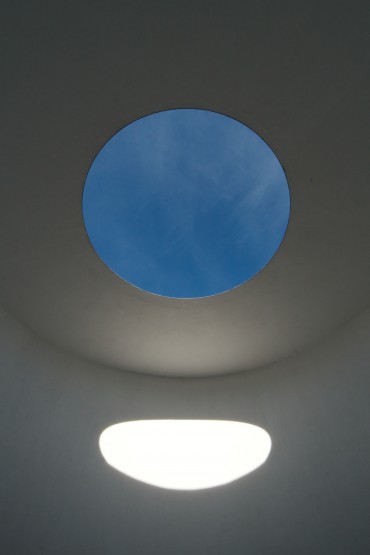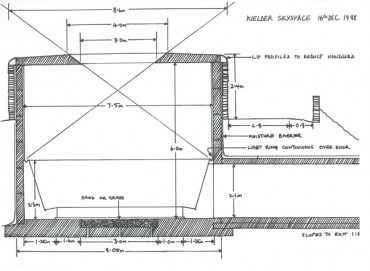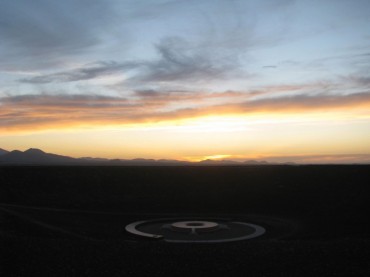
Cat Cairn: the Kielder Skyspace, 2000 Photo: Tom Parnell

Cat Cairn: the Kielder Skyspace, 2000 Photo: Peter Sharpe

Section

Crater Eye Plaza at Roden Crater, Arizona, since 1972 Photo: Edwin C. Krupp
16.7.2014 – Issue 15 - Fire – von Mackensen Till – Essays
James Turrell: Skyspaces - Earthly Periscopes
by Till von Mackensen
Overlooking a smoothly curved hillside partially covered by forests, a rocky figure emerges from the earth. At a distance one can distinguish a rough shape growing out of its top. Stones of irregular formats have been layered to a soil-coloured cylindrical shape. From some angles the figure melts into the landscape while from others it stands out from the pale sky.
The Kielder Skyspace is approached laterally. The impression is an access from below which leaves the object itself untouched. By a slightly upwards sloped cylindrical tunnel, a deep hole in a containing wall, the main space is entered. Having penetrated the earth the landscape almost completely vanishes out of one‘s perception. As the horizon disappears the vertical gains presence. Smooth, round concrete surfaces offer no anchor point for the view. The only possible perspective is the sky and its physical counterpart the centre of the room - a dark gravel surface allowing the rain to drain into the earth. A sharp edged slab makes the sky almost physically tangible. Observed through this passe-partout cloud formations turn into paintings seen from inside the earth. The ever changing light conditions are amplified and somewhat concentrated by the precise angles of the bright reflecting interior geometry.
Over the years the American artist James Turrell has been able to realize a great variety of such Skyspaces at diverse locations all over the world. Jerez de la Frontera in Spain, Zuoz in Switzerland only to name two, or the Air Apparent Skyspace in Tempe, Arizona: A surprisingly light structure of steel and glass with a slab suspended by cables in the air above it. The walls become a greenhouse like glass filter, blurring the view instead of the hard and consistent shell. Nevertheless, a repetitive scheme of contemplating the sky and the light radiating from it is inserted into each context. Some of them as the Kielder Skyspace seem to be rooted not only in the present of a site but also anchored to its memory: like an ancient artefact it reminds us of something deep in the collective subconscious that we might have almost forgotten.
In Air Mass Turrell describes an experience of his childhood: The penetration of daylight through little needle holes in a black curtain that created from the inside the illusion of a star sparkled sky – a different reality. In a way we could understand his Skyspaces in a similar way: very partial impressions of the light filled atmosphere revealing its own reality to everyone. The Skyspaces are quiet places that offer a common ”oculus” to every visitor: earthly periscopes to provide a unique perception of one’s sky that looks back on us. In Roden Crater - an extinct natural volcano at the southwestern edge of Arizona‘ Painted Desert that Turrell has been transforming into a large-scale artwork relating to the light of the sun, moon and celestial vault since 1972 - these objectives crystalize in a series of chambers, pathways, tunnels, and openings to bring the sky and earth into an experiential relationship that harnesses the sensation of light as a material substance.
Download article as PDF

